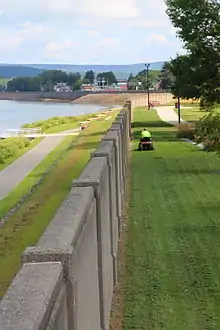


A floodwall is a freestanding, permanent, engineered structure designed to prevent encroachment of floodwaters.[1] Floodwalls are mainly used on locations where space is scarce, such as cities or where building levees or dikes (dykes) would interfere with other interests, such as existing buildings, historical architecture or commercial use of embankments.
Floodwalls are nowadays mainly constructed from pre-fabricated concrete elements. Floodwalls often have floodgates which are large openings to provide passage except during periods of flooding, when they are closed. As a floodwalls mostly consist of relatively short elements compared to dikes, the connections between the elements are critical to prevent the failure of the floodwall.
The substantial costs of floodwalls can be justified by the value of commercial property thus protected from damage caused by flooding. Floodwalls are sometimes bad for ecosystems.[2] Floodwalls are almost always built in cities.
See also
References
- ↑ "Floodwalls". www.geo.fu-berlin.de. 2016-10-24. Retrieved 2023-01-22.
- ↑ Serra-Llobet, Anna; Jähnig, Sonja C.; Geist, Juergen; Kondolf, G. Mathias; Damm, Christian; Scholz, Mathias; Lund, Jay; Opperman, Jeff J.; Yarnell, Sarah M.; Pawley, Anitra; Shader, Eileen; Cain, John; Zingraff-Hamed, Aude; Grantham, Theodore E.; Eisenstein, William (2022). "Restoring Rivers and Floodplains for Habitat and Flood Risk Reduction: Experiences in Multi-Benefit Floodplain Management From California and Germany". Frontiers in Environmental Science. 9. doi:10.3389/fenvs.2021.778568. ISSN 2296-665X.
External links
- DeltaWorks.Org Flood Barriers project in the Netherlands
